Feature

IN FALL 2014, the St. Louis Symphony Orchestra performed Brahms’ Requiem on a Saturday evening two months after the murder of Michael Brown Jr., at a concert hall about 10 miles from Canfield Green, where Brown was killed and his adolescent body left out in the Missouri August sun for four and a half hours.
That summer and fall, people in the city and county of St. Louis lived in the tension of waiting — we were waiting for a grand jury to make a decision. Not a verdict about the officer’s guilt: The grand jury was tasked with deciding whether this murder was even a murder at all — whether anything happened on Aug. 9 that could even be considered maybe a crime. Maybe worth investigating. Or whether it was just a regular day’s work.
As intermission was ending and folks were back in their seats, just as the orchestra was regathered and the conductor was raising his baton, a small group of ticketholders in the audience stood up and sang. In singing, they asked the audience, made up largely of people who could choose whether or not they were impacted by the grand jury’s decision that loomed over the city like the shadow of death, to make a decision of their own. They stood up, one by one, and joined their voices in an old labor song: “Which side are you on, friend, which side are you on?” they sang. “Justice for Mike Brown is justice for us all. Which side are you on, friend, which side are you on?” They hung banners made of bedsheets over the balcony; one that echoed the piece being performed that evening was painted: “Requiem for Mike Brown, 1996-2014.”
These protesters brought this question — this disruption — into a space that could’ve kept it to business as usual. They sang the two refrains in repetition, almost like a Taizé chant, for several minutes, then they left the hall together, chanting a chant that at the time was still brand-new to most Americans: Black Lives Matter.
The disrupters left to a mix of silence and applause from the audience and the musicians. The concert continued, but the question hung in the air. It’s the same question that hangs in the air of many of Jesus’ disciple-calling stories, and it’s certainly the question that pervades Matthew’s telling of Jesus’ good news.
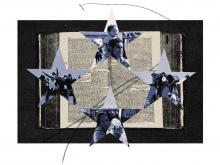
RELIGION PROMOTES WHAT is good in humanity — mercy, wisdom, charity, justice, compassion. These are fundamental to most religious traditions. But religious institutions and movements consist of humans capable of both good and evil, truth and lies, peaceableness and violence. Most Americans have positive feelings about the role religion plays in American life, according to recent surveys. But more than 75 percent are against religious organizations endorsing political candidates or getting involved in partisan politics.
Religious zeal and political power can be an explosive combination — which is why the First Amendment promotes the separation of these powers. Yet the heart and faith of voters impact their choices in the polling booth — and the emotions and imaginations of voters can be swayed by media, social groups, and targeted manipulation to impact an individual’s vote.
One form of manipulation is through conspiracy theories — and conspiracy theories that manipulate religious and social imaginations are particularly potent. They are not new — recall the early U.S. grassroots movements, such as the Anti-Masonic Party and the Know-Nothings, who fought against perceived threats to Protestant Christian values, as well as the John Birch Society’s modern links to the Christian Identity Organization.
As conspiracy theories, disinformation, and populism become more mainstream, one less-understood conspiracy is having an outsized impact on immigration laws: The “great replacement theory” promotes the idea that nonwhite people are brought into the United States and other Western countries to “replace” white voters as part of a godless, liberal political agenda.
The 2017 “Unite the Right” rally in Charlottesville, Virginia, reminded many Americans that the horrors of organized hate were not something in the past. The refrain by white nationalists of “You will not replace us!” recalled virulent antisemitism and anti-immigrant rhetoric of earlier eras. The media repeated the slogan as it tried to make sense of how domestic terrorism, spurred on by online rhetoric regarding the removal of Civil War statues, could have culminated in such social violence and the murder of Heather Heyer by neo-Nazi James Fields Jr. It was a traumatic moment among many in America.

MY DAD HAD a very mixed relationship with America. Based in his experience of and feelings concerning white supremacy in America, I was never sure he loved America and knew with certainty that he hesitated to call it “home.” America was never holy ground for him.
On Jan. 6, 2021, while I was watching the Capitol insurrection on TV, he died in his hospice bed. My screen view of the Capitol mob’s recitation of “hang Mike Pence,” in rhythmic incantation to bring forth the blood-boiling hate, was reminiscent of the ritualistic lynching of thousands from 1870 to 1940, particularly and almost exclusively African Americans.
I also had a screen view of my dad. Given the threat posed by COVID-19 exposure upon his chemotherapy-treated and compromised immune system, we were not able to visit him as we would have liked. My sister had installed a camera system to get a visual. I noticed that he was not moving. I earnestly studied his lack of motion and noticed that his mouth was wide open. This was the death posture. I instantly knew he was gone.
Trying to come to grips with the death of my father, while staring with glazed-over eyes at the Capitol riot, I said to myself: “The insurrection took my dad out of here. He had enough of white supremacy in America.” During the chaos of the insurgency, my dad became an ancestor. In the stark reality of his death, I realized he had been in search of holy ground for a long time.

IN SEPTEMBER 1987, ordained Methodist minister and practicing physician G. Scott Morris opened Church Health, a faith-based health care center in Memphis, Tenn. The first clinic tended to 12 people. Over 35 years later, more than 80,000 different individuals have come through Church Health’s doors. When they started, Memphis was the poorest city in the country, but Morris and companions didn’t open Church Health center as an act of charity. Church Health’s mission has always been about demanding justice. His book Care: How People of Faith Can Respond to Our Broken Health System tells the story of clinics across the U.S. where people practice Jesus’ command to heal. — The Editors
I FIRST CAME to Memphis in 1986. Having completed my theological and medical education, I was determined to begin a health care ministry for uninsured people working in low-wage jobs. I had dreamed of this for years as I slogged my way through the training that would make it possible. When the time came, I chose Memphis because historically it is one of the poorest major cities in the U.S. Today we see patients in clinics for primary care, urgent care, dental work, and optometry services. Behavioral health, life coaching, and physical rehabilitation are integrated into our clinics, and we have a teaching kitchen offering classes on culinary medicine for patients and the community. The Church Health model is used in more than 90 clinics around the country. There are about 1,500 free and charitable clinics in the U.S., many of which have faith-based connections.
God calls the church to healing work. Jesus’ life was about healing the whole person, and Jesus is the church in the world. Tradition suggests that Helena, the mother of the emperor Constantine, was the first to open a hospital specifically to care for the poor. The ancient world never had a system to care for the sick who were poor until Christians offered hospitals. Even Julian the Apostate, a fourth-century Roman emperor who did not have much use for Christians, wrote, “Now we can see what it is that makes these Christians such powerful enemies of our gods, it is the brotherly love which they manifest toward strangers and toward the sick and poor, the thoughtful manner in which they care for the dead, and the purity of their own lives.” We are still Jesus’ disciples, the body of Christ running after God’s priorities in the world together. What does it look like to have a healing ministry in today’s world?
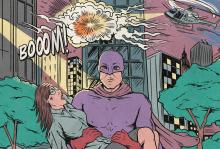
EVER SINCE I was little, my imagination has been shaped by superhero worlds, lore, and comic and animated adaptations. And while more “realistic” adaptations are the trend on the big screen, what enthralled me about characters such as Batman wasn’t that I thought he could be real; I was tuned instead to the ethos behind the caped crusader.
Superhero stories often seem limitless. At their best, they stretch the imagination to ask what type of world we want to exist and what it would take to get us there, while acknowledging hardships along the way.
Recently, I began a rewatch of the DC Animated Universe: TV shows, feature films, and shorts that aired mainly from 1992 to 2006. These shows were the first to capture my attention and shape my imagination. Batman: The Animated Series was my first love, with Kevin Conroy’s Batman and Mark Hamill’s Joker seared into my consciousness. As I watched, I made a particular note about the moral imagination of these shows: Superheroes in these shows don’t just refuse to kill — a theme recurring across superhero worlds — they refuse to even let anyone die.
Take Season 1, Episode 11 (S1 E11) of Superman: The Animated Series: Lex Luthor’s weapons factory is about to explode, with spilled molten metal splashing about. Lana Lang is hanging by a thread above certain death; so is Lex Luthor, who unintentionally caused this mess in his attempt to kill Superman. But then, at the last moment, Superman bursts forth from under the molten waves, crashing out of the top of the factory just before it explodes, with Lana in one arm and the villain in the other.
It’s a scene that strains credulity. There’s an improbability of timing, a lack of “logic” in doubling back for the person trying to kill you, and the storyteller’s refusal to explain how Superman managed to save the villain. But what’s key here is the insistence, and flaunting, that Superman would save the villain. It doesn’t need an explanation; it’s assumed.
For a while, I was paying attention to how the writers made this subtext believable. Superman saves some villains in hopes they can be rehabilitated, others because they are being used by larger, more villainous characters. Why? The simple answer is that these were shows for families and children. The same reason the comic book’s “League of Assassins” became the TV show’s “Society of Shadows” and villains set out to “destroy” rather than “kill” heroes.
But this death-resisting subtext becomes dialogue in S2 E9 of Superman: The Animated Series when some kids plead with Metallo, a villain disguised as a hero, to save Lois Lane from an exploding volcano. “Superman wouldn’t let anyone die, no matter how bad they were,” the kids protest. “I’m not Superman,” Metallo retorts.
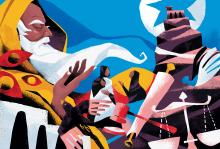
IN 1991, FOUR Los Angeles police officers beat Rodney King, a 25-year-old African American man, nearly to death. It was caught on video. All the officers were acquitted of assault with a deadly weapon. The acquittals were followed by six days of rebellion with more than 50 associated deaths. At that time, I and many other white Christians fixated on our desire to see “peace” restored. Even in the face of graphic police brutality, I was unable to see the pernicious racial injustice that created the context for the riots. The white Christianity of my upbringing did not equip me with a biblical lens through which to discern the truth about racial injustice in the U.S. It would be nearly a full decade before I could finally begin to perceive it.
Nevertheless, in light of the role white Christian nationalists played in the Jan.6 riot, the number of pastors who preach against Black Lives Matter and critical race theory, and the deafening silence and stubborn inaction of many white Christians in the face of explicit cries for racial justice, I have to ask: Will this generation of white American Christians be just another in the long line to embolden racial injustice?
Where do we turn to find hope, inspiration, and guidance to help white Christians finally commit to our God-given vocation to do justice instead of holding tightly to our idolatrous commitment to white supremacy? I look to the little-known biblical prophet Zechariah and how he called a generation returned from exile to live out God’s call to do justice.

CHRISTIAN MYSTICS HAVE a definite dramatic streak. Their transformative encounters with God are full of divine revelations (Julian of Norwich), ecstatic visions (Teresa of Ávila), stigmata (Francis of Assisi), erotic imagery (John of the Cross), and all manner of artistic compositions (here’s to you, Hildegard of Bingen).
But then there’s Brother Lawrence who — if he is known at all — is known for experiencing God’s presence as he washed dishes, cooked eggs, or did other monotonous chores that came with life in a 17th-century French monastery.
Born Nicolas Herman, he emerged from one of Europe’s deadliest religious wars a disabled veteran. Haunted by his past actions and convinced he was eternally condemned, he failed as a hermit (too much time alone with his thoughts), then as a footman (“a clumsy oaf who broke everything,” he recalled), before eventually joining the lay brothers of the Order of the Discalced Carmelites in Paris in 1640. Yet Brother Lawrence’s anxiety persisted. When he tried to pray, he spent the whole time “rejecting thoughts and then tumbling back into these same thoughts.” Eventually, he gave up all his spiritual exercises and focused on becoming aware of God’s presence as he did his assigned work in the monastery’s kitchen. What he experienced wasn’t a celestial vision, but what he had sought all along: God’s peace.
“We go to such great lengths, trying to remain in the presence of God by so many methods,” he told a friend who posthumously published Lawrence’s modest writings and letters. “Isn’t it much shorter and more direct to do everything for the love of God?”
Carmen Acevedo Butcher, an award-winning translator of mystical and classic Christian texts, was drawn to Brother Lawrence’s gentle practice. Acevedo Butcher herself grew up saddled with severe “self-loathing” and anxiety from a childhood shaped by trauma, hellfire preaching, and the strain of being “a brown girl in a white society.” But in Lawrence’s writing she finds someone who experienced real Love amid real pain.
In Practice of the Presence, Acevedo Butcher’s new English translation of Brother Lawrence, she emphasizes his embodied joy and his “original welcoming spirit,” which she sees in his frequent use of tout le monde — “for everybody.” Drawing on Lawrence’s deeply trinitarian theology, Acevedo Butcher uses they/them pronouns for God, a move she hopes will communicate Lawrence’s kind, inclusive understanding of Love to a wide audience. Acevedo Butcher spoke with Sojourners’ Betsy Shirley about translation, mysticism, and how Brother Lawrence’s practice connects to the work of social justice today.
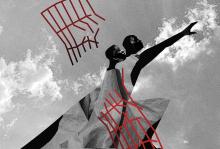
BLACK LIVES MATTER. In the years since 17-year-old Trayvon Martin was murdered in his hoodie carrying Skittles, we have learned why this phrase is not simply a consequence of all lives mattering. The world systematically devalues Black life, turns Black life into death-bound life, and it is our task — as justice seekers and as Christians — to embrace Black resurrection.
Politically that makes sense, but what does it mean theologically? Surely Christianity proclaims that all might be saved, independent of skin color. A half-century ago, James Cone and fellow Black theologians embraced this theological challenge head-on. They charged that the possibility of life after death for any individual is inextricably linked to the struggle against the death-dealing forces of white supremacy. How might we fill out this insight today, with Black Power slogans themselves finding new life and new form as activists embrace Black joy, Black excellence, Black rage, Black love, and Black dignity?
In a definition that has rapidly gained traction in activist circles, Black prison abolitionist and scholar Ruth Wilson Gilmore defines racism as “the state-sanctioned or extralegal production and exploitation of group-differentiated vulnerability to premature death.” Black studies scholars have refined and deepened this claim, arguing that anti-Black racism names a system of laws, institutions, feelings, and even forms of seeing and thinking that make Black life particularly vulnerable to premature death. Slavery may have ended in the 19th century, but many of the structures and habits that made slavery possible, that made it plausible for Black human beings to be treated as less than human, persist, and those structures and habits function by making Black life precarious. One false move, and the police officer or prison guard or neighbor or privileged “Karen” may invoke the violent power of whiteness to put an early end to Black life.
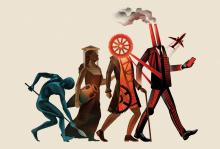
PHILIP JENKINS’ REMARKABLE Climate, Catastrophe, and Faith: How Changes in Climate Drive Religious Upheaval leads off with Voltaire: “Three things exercise a constant influence over the minds of [humankind] — climate, government, and religion ... That is the only way of explaining the enigma of this world.”
Climate and geology are now the new prisms for our shared discernment of how we are to live in our own time and place as followers of Christ. We’re driven to centering climate because we can no longer live with the expectation of the balanced climate of the last 12,000 years, the geologic epoch called the late Holocene. We are now in a new geologic epoch: the Age of the Human, or the Anthropocene.
Anthropocene reality leaves Christian ethics nowhere to hide. Nowhere to hide because unprecedented cumulative human powers doubled down on planet-spanning changes that launched the first geological epoch created by human choice and action. The fact that human choice and action has done this means that everything, including extinction, turns on ethics. As Christians, we can look away and abdicate our responsibility, but we cannot escape the massive human presence that lines out our lives — and all life. We’ve become totalizing creatures. We humans are, for the first time, both ark and flood.
This extraordinary power has been recognized for a while. In 1944, Dietrich Bonhoeffer wrote that the unprecedented powers of modern science and technology led to a world in which “it all comes down to the human being,” a world where “everything turns upon humanity.” He thus set out to reconceive human responsibility for a world that had come of age. For Bonhoeffer, “world come of age” was not a statement of moral maturity. It was a statement of moral accountability. People who legally come of age at 18 or 21 are accountable, whether they exercise their agency maturely or not. When everything turns on humanity, Bonhoeffer said, the whole human world has arrived at that point of accountability.
A current term for human powers and their collective impact is “assisted evolution.” But the phrase is deceptive because it hides the depth, breadth, and temporal reach of those powers. Does the phrase “assisted evolution” reveal that the carbon people produce has the ability to alter marine chemistry, flood coastlines, strip glaciers “to bare bones,” embolden deserts, warp the circulation of ocean currents, “supercharge extreme weather events,” and rearrange “the distribution of animal, plant, and microbial species across the globe,” as author David Farrier puts it? This isn’t evolution “assisted”; it’s evolution hacked and hijacked.
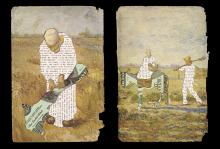
IN A JUST ECONOMY, everyone who wants a job has one, and it pays a living wage, sufficient for workers and their families to thrive. Everyone’s material needs — for nutritious food, safe and secure housing, transportation, clothing, utilities, education, health care, and economic security — are met. Economists call this full employment in living wage jobs, and it is a goal of many justice advocates. It is also God’s vision for society.
Jesus told the disciples that he came so all may have abundant life (John 10:10). As Jesus showed, God’s vision encompasses more than abundant spiritual life. Jesus understood that God’s vision of abundance encompasses material needs as well as spiritual ones. Jesus healed broken bodies. He fed hungry people and encouraged others to do so as well. In God’s reign, everyone’s material needs are filled. But how does God envision this to happen?
The Old and New Testaments reveal a great deal about God’s intentions for the economy, the word we use to describe the way in which we use God-given natural resources — soil, rain, sun, fuels, minerals, trees, etc. — in combination with human effort and ingenuity (also given by God) to produce all our goods and services. We can gain important insights relevant to our economy today by examining the economic circumstances of the Israelites during three different biblical eras and then exploring what the biblical writers and Jesus taught about the economy and economic injustices during those periods.
Over the more than 10 centuries during which the biblical narrative was composed, the economic circumstances of the Israelites changed markedly and, in response, so did the economic instructions in the Bible. But, surprisingly, in each of the three eras, the instructions called for livelihoods for all that enabled thriving or, in our language today, full employment in living wage jobs.
In the Old Testament — the Hebrew Bible — the economic instructions are part of the laws found in Exodus, Leviticus, and Deuteronomy. Today, Christians often insufficiently value this body of law. Some of it seems strange to our modern ears. Other provisions fall far short of current standards for justice — for example, slavery and patriarchy were normalized then. Certainly some of our laws today will fall short of more enlightened future standards. But as we will see below, the law contains much timeless wisdom. To the Israelites, the law was a gift from God, a blessing, a guide to more joyful and fulfilling lives lived in right relationship with God. Psalm 23, one of the most beloved and well-known biblical psalms, tells of the comfort derived from God-the-Shepherd’s rod and staff, tools used to guide sheep in safe, life-giving paths. If we are open to it, we can gain important insights from the ancient laws.
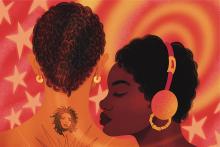
MUSIC IS MY safe space. When all hell is breaking out, I can put in my AirPods and turn on part of the soundtrack of my life and reset. The pandemic created a chronic hell that illuminated oppressive forces that have existed for centuries. Music became even more essential for my survival.
I am a Black clergywoman who is clear that “my emancipation doesn’t fit” many people’s equation. Let me say that another way: My authentic expression of self makes some people uncomfortable. My unapologetic expression of womanist Blackness often sheds light in the shadows of a corrupt world.
I won’t pretend that I have always felt free to be me. It took a pandemic to give space to be reminded by theologian and prophet Lauryn Hill that “deep in my heart, the answer, it was in me.” Hill’s lyrics and very existence compelled me to “[make] up my mind to define my own destiny.”
Some consider Hill to be one of the greatest lyricists of all time. An eight-time Grammy winner (with 19 nominations), she sings, raps, and acts. She is hip-hop royalty. In the ’90s, I wanted to be her. She wore the dopest locked hair style, had the most beautiful brown skin, and expressed her Blackness with boldness and class. She had, and still has, a lyrical flow that men and women couldn’t ignore. She was fly. (Translated as cool, sexy, smart, and stylish.)
Her industry-shaking debut solo album The Miseducation of Lauryn Hill, released in August 1998, will stand the test of time. Hill speaks truth in ways that penetrate the soul. I was a young mother when the album came out. She articulated things that only a Black woman could identify with. She spoke of the tension and beauty of having a child when society was telling her that motherhood and a career couldn’t coexist. She sang and rapped about self-respect, love gained, and love lost. This album is life. This album ministers. This album is sacred.
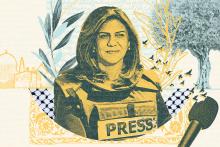
PALESTINIAN AMERICAN JOURNALIST Shireen Abu Akleh was shot and killed in May 2022 while covering an Israel Defense Forces raid on a refugee camp in the Palestinian West Bank village of Jenin. Abu Akleh had been standing with a group of other journalists and was wearing a blue vest with the word PRESS printed across it when she was shot; her producer was shot in the back but survived. Hours after Abu Akleh’s death, Israeli police went into her home, took away Palestinian flags, and prevented the singing of Palestinian nationalist songs.
In mid-November, the FBI opened an investigation into Abu Akleh’s death; Israeli Defense Minister Benny Gantz said Israel would refuse to cooperate since, Gantz said, the IDF had already investigated the IDF actions in the shooting. The U.S. State Department commented, “Not only was Shireen an American citizen, she was a fearless reporter whose journalism and pursuit of truth earned her the respect of audiences around the world.”
Before her death, households throughout the Arab world knew Abu Akleh’s work. Nicknamed “the daughter of Palestine” — and “the voice of Palestine” — Abu Akleh had worked for Qatar-based news outlet Al Jazeera for a quarter century. Viewed as courageous and thoughtful, Abu Akleh inspired many, including women interested in pursuing a career in journalism in the Middle East. A common signoff for her broadcasts summarized her motivation for being a journalist: “I chose journalism to be close to people. It might not be easy to change the reality, but at least I can bring their voices to the world. I am Shireen Abu Akleh.”
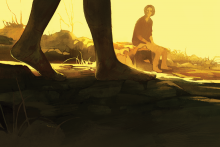
APRIL 2019. On the second day of our 65-kilometer walk on the Jesus Trail in Galilee, I began feeling dizzy and faint. Berry, my hiking partner, told me to drink more water. That helped, and we were able to make our way from Nazareth to our next stop in Cana, site of a wedding Jesus attended.
But the Jesus Trail continued, often on narrow stony paths speckled with animal droppings, up and down hillsides, across streams of springtime water where thistles grew over our heads, through meadows of waist-high grasses, and finally up and over Mount Arbel leading down to the Sea of Galilee. Our destination was Capernaum, site of Jesus’ headquarters during his ministry.
Exhausted at the end of our hike and with blistered feet, I turned to Mark’s gospel. Already in 1:21, Jesus “went to Capernaum”; the next morning he “went to a deserted place to pray” (verse 35). Then he “went throughout Galilee, proclaiming the message” (verse 39). I will never read the words, “Jesus went” the same way again. Not by horse, carriage, automobile, train, or plane. Not communicating by telegram, radio, phone, email, YouTube, or Zoom. Just trudging by dusty, sandaled feet, bereft of Nikes!
‘Lords of the world’
SINCE THAT HIKE, I have been pondering the Incarnation. Was it necessary for the Infinite One to go that far down? To be born a lower-class, brown-skinned, black-haired Middle Eastern Jew whose only means of transport was by scratched and calloused feet? To live under an enemy occupation determined to keep its subjects poor and politically powerless?
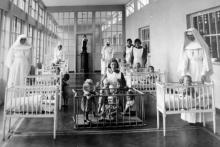
WHEN MARI STEED began searching for her birth mother in Ireland, she knew little about the system of secrecy and abuse that would lead her to co-found a social justice group to right its many wrongs. Born in 1960 in a convent-run “mother and baby” home in County Cork, Steed was one of more than 2,000 “banished babies” adopted from Ireland to the United States beginning in the 1940s. As an 18-month-old, she was taken to Philadelphia.
When Steed became pregnant as a teen, she was put in a Catholic-run home in Philadelphia and made to give up her child. In the mid-1990s, she decided it was time to find both the daughter who had been taken from her and the birth mother from whom she’d been taken. Her American family were “decent people,” Steed told me. “I don’t have any serious qualms with my upbringing. But I did begin to search for my mother to find out more about where I’d been.” She created a website to connect with other adopted people of Irish birth.
Eventually, Steed learned her mother, Josie, had given birth to her out of wedlock and had been born to an unwed mother herself. In Ireland, such circumstances put Josie on the full merry-go-round of church-and-state institutions before the age of 30: a county home, an industrial school, 10 years in a “Magdalene laundry,” and finally the mother and baby home. Steed, who lives in Virginia now, recalled she at first had no clue what all this information meant. “‘What are laundries?’ I didn’t even know what that was at the time.”
The answer led Steed down a rabbit hole of secrecy and obstruction. Originally founded in the 18th century as places of refuge for so-called “fallen women,” Magdalene laundries evolved into institutions where women and girls labored for no pay as penance for transgressing Catholic Ireland’s moral and class codes. In his book Ireland’s Magdalen Laundries and the Nation’s Architecture of Containment, Boston College professor James M. Smith described a system of interconnected institutions “including mother and baby homes, industrial and reformatory schools, mental asylums, adoption agencies, and Magdalen laundries.” (Ireland’s first such institution was called the Magdalen Asylum for Penitent Females, using an archaic spelling of Magdalene.)
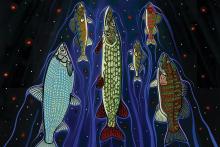
TO THE LEFT of a buffalo photograph on my wall, a rosary hangs from a thumbtack. Frequently, my eyes linger there. It came to me a couple of years ago on my birthday as part of a gift from my mother — looped through the ribbon of a wrapped box that contained a tea set. When I held the rosary before my face, I found it curious. My mother explained that it had been my late father’s, and that it was one of his most prized possessions. I was a little stunned because I had never seen it before. It was a gift, my mom continued, made by his grandmother who died two years before I was born. Now, it had come to me.
My great-grandmother’s parents were part of a group of 25 Red River Métis families who settled on Spring Creek in central Montana in 1879, an area now known as Lewistown. They, like all the tribes of the region, were pursuing the final dwindling herds of buffalo. It was a tumultuous time to be Indigenous, with settlers flooding the landscape from all points east and gobbling up land, whether it had been promised to Indians or not.
The origins of my Métis people can be found in the late 1600s, and likely earlier, when the first European traders first began establishing trading posts in the Red River Valley. This region, named for the mighty Red River of the North, is centered at what is now Winnipeg, Manitoba, and extends into today’s Minnesota and North Dakota. These early Europeans, mostly from France — with some coming from Scotland, Wales, and England — married into the Indigenous people already inhabiting the region: Cree people and Ojibwe people. From these unions sprang descendants who created their own unique, mixed-culture people — the Métis.
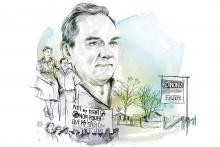
CLARENCE L. JORDAN died on Oct. 29, 1969, at 57 years old. The radical Southerner who dedicated his life to farming, sharing the gospel, and imploring his neighbors to actually follow Jesus is not widely remembered. Jordan died as simply as he lived — buried in a wooden box used to ship coffins, in an unmarked grave, and wearing his overalls. In early 2020, a little more than 50 years after Jordan (pronounced “Jurden”) died, I came across his work and was enamored. I began reading anything from or about him I could find. Jordan’s Georgia roots and love for the South mirrored my own. His charm and cutting humor were irresistible. Most appealing was Jordan’s stubborn commitment to radically following Christ, which led him to reject and rebuke the practices of racism, capitalism, and militarism in the U.S.
On the podcast Pass the Mic, writer Danté Stewart put a name to what I found in Jordan. “The reason why white [siblings] are struggling in this moment is because most of their models have been violent white supremacists,” Stewart said. “White [siblings], they don’t have models of liberation and love, so therefore they’re struggling in this moment.” Clarence Jordan was a “model of love and liberation” that we can learn from now. The dehumanizing forces of racial capitalism and militarism are no weaker in the U.S. today than in his lifetime, and many white Christians are avid proponents of both. Jordan’s resistance and radical theology did not die with him; instead, they can evolve and grow with the times. We should engage Jordan without idolizing him and advance his core commitments with a critical eye, honestly appropriating them for our modern struggles.
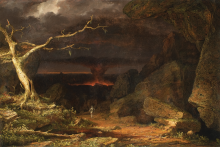
THE EARTH SEEMS ablaze. Each year, flames appear more savage, more far-ranging, and more inescapable. The prophecy of Ezekiel is coming to pass: “They shall go out from one fire, and another fire shall devour them” (15:7). The planet is, as some see it, careening toward a secular apocalypse.
To be caught between two fires is an old notion. But a lot has changed since Ezekiel’s warning. Today, we do not have to cope with two fires but with three. The first is the fire that has burned as long as terrestrial vegetation has existed. The second is the fire that humans tamed from the first. The third involves burning fossil fuels. The three fires together are shaping our world, which makes humanity uniquely suited to serve as a steward, for we are Earth’s fire creature, the only one with the systematic capacity to start and stop flame.
WESTERN CIVILIZATION HAS a long heritage of fire myth, lore, religion, and science. Early Indo-Europeans seem to have worshiped a fire deity. Of the 12 ancient Olympians, two were gods of fire — Vesta for the hearth, Vulcan for the forge. Ritual fire became a fundamental practice of Zoroastrians, among the first of the monotheisms. New colonies or dislocated peoples would take fire from their mother city to literally “rekindle” its offspring. The hearth fire, most famously in Rome, stood for both family and state. Pyromancy, the practice of divining meaning in flames, is an old practice.

Three ways churches can decenter themselves and economically empower their communities.
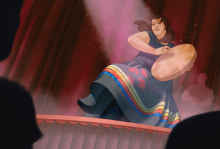
This article is adapted with permission from Becoming Kin: An Indigenous Call to Unforgetting the Past and Reimagining Our Future by Patty Krawec. © 2022 Broadleaf Books.
I WAIT AT the back of the stage, behind the curtains, holding my hand drum and listening to the low buzz of a theater filled with people. My friend Karl stands in the darkness at center stage, waiting for me to start singing and make my way to where he stands. We are providing an opening for the Niagara Performing Arts Center’s season preview. It is not a Native event. The center is a public arts venue that showcases a wide range of performers, and the artistic directors include Native artists throughout the regular season. They have asked Karl and me to open this particular night as an acknowledgment that this and future events take place on Haudenosaunee and Anishinaabe land.
It is fall 2017, 150 years since Canada’s confederation, and I’ve made a ribbon skirt to wear at this event. Ribbon skirts—long cotton skirts embellished with rows of ribbon and sometimes with appliqued designs—are a contemporary innovation of an older style of clothing that we wore before settler contact. The ribbon skirt I’ve made for this evening is black with wide ribbons in the colors associated with the medicine wheel: red, black, white, and yellow. I have appliqued red maple leaves falling down the front of the skirt until they are covered by ribbons. I like the imagery of Canada being absorbed by Indigenous ideas. Later, during the gathering after the event, a couple of women will come to speak with me. They will comment that the leaves are upside down. A nation in distress flies their flag upside down, I will tell them. And Canada, like the United States, is a nation in distress.
There is the beat of the drum in that darkened theater and then my voice coming from the back of the stage. I move toward the front, singing each verse louder as the lights come up. When I finish, Karl speaks the words of the Haudenosaunee Thanksgiving Address in Oneida. Then we simply leave the stage. Not explaining the song or our actions or our words is deliberate. We let the audience sit for moment and consider that what feels profoundly alien to them is not alien at all. For one brief moment, they are surrounded by the sounds of this place.
That evening before we go on stage, Karl and I talk about whether Christianity and Indigenous worldviews can ever be reconciled, if there is any common space. He doesn’t think so. Karl is Oneida and part of the Haudenosaunee Confederacy. Hundreds of years ago, when it became evident that the newcomers were going to stay, he says, the Confederacy made a treaty with the settlers called the Two Row. This is written in the form of a wampum belt made of oblong purple and white beads, with two white rows on a purple background. The agreement was that we would travel together, the Indigenous peoples and the settlers, each in our own boat but on parallel paths in a relationship guided by peace, honesty, and respect.
The principle of noninterference lives at the root of many Indigenous philosophies and is exemplified in treaties like the Two Row: We would live according to our ways, and the newcomers would live according to theirs. Although colonization is clearly a violation of this treaty, the Haudenosaunee people I know remain committed to it and continue to try to live within these principles.
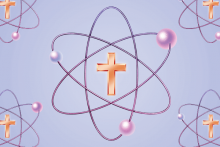
ON A RECENT morning run, I saw a yard sign that began, “We believe ...” and included a list of creedal-like commitments. One stood out: “Science is real.”
Science? I thought. Does belief in science really need front-yard creedal affirmation?
One trend of the recent divisions in our nation is a heightened distrust in science among evangelicals and the Religious Right. This pattern has been acute during the COVID-19 pandemic, when research by epidemiologists and other members of the scientific community has been increasingly called into question by conservative pundits, political officials, and religious leaders. The costs of this rhetoric and its effects have grown far beyond alarming.
Where did this science and religion rift come from? And how can we speak into the fear and mistrust in the work of science that has taken root in recent years in a way that cultivates trust and encourages mutual concern?
The origins of this rift are not easy to trace, fed as they are by a variety of sources. Thomas Dixon, in the book Science and Religion: A Very Short Introduction, attributes the science-religion conflict narrative to three sources: Enlightenment rationalists in the late 1700s, Victorian “free-thinkers” in the mid-1800s, and modern-day scientific atheists at the end of the 1900s to the present. “Few things make thinking like a scientist more difficult than religion,” wrote Sam Harris, a prominent atheist, in The New York Times in 2009.
Great numbers of contemporary Christians have arrived at the opinion that their faith tenets and the work of science are in conflict, though this is far from a homogenous view. According to Pew Research Center analysis of data from the Wellcome Global Monitor, there is a wide variation in views among global Christians on the relationship between science and religion. Christians in the U.S., for example, far exceed Christians in other parts of the world in reporting that science has conflicted with their religion’s teachings: 61 percent of U.S. Christians reported such conflict, compared to 22 percent in Singapore, 18 percent in Sweden, and 12 percent in the Czech Republic. According to the National Association of Evangelicals, evangelicals in the U.S. are more than twice as likely as the general public (29 percent vs. 14 percent) to hold the view that science and religion are in conflict.
At the same time, for many other Christians science represents a path toward God, not away. “Doing science to me is a search for God,” George Coyne, a Jesuit priest, astronomer, and former director of the Vatican observatory told On Being podcast host Krista Tippett. “And I’ll never have the final answers, because the universe participates in the mystery of God.”
The growing distrust in science among some people of faith has become a matter of life and death during the COVID-19 pandemic. White evangelical Christians represent the highest rates of vaccination hesitancy among religious groups in the United States. How, then, are we to engage our neighbors, aunts, brothers, or parents in a way that counters misinformation and rebuilds trust?